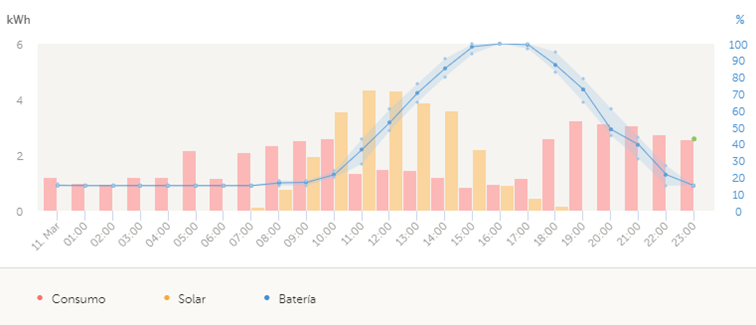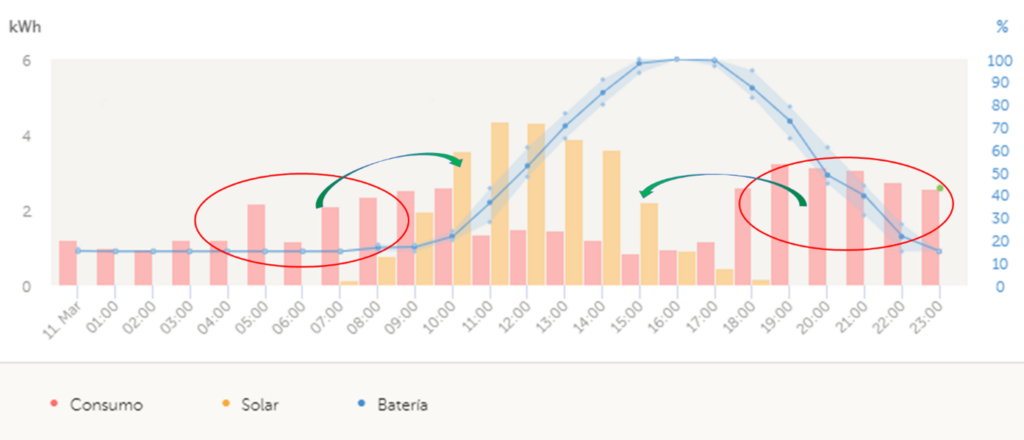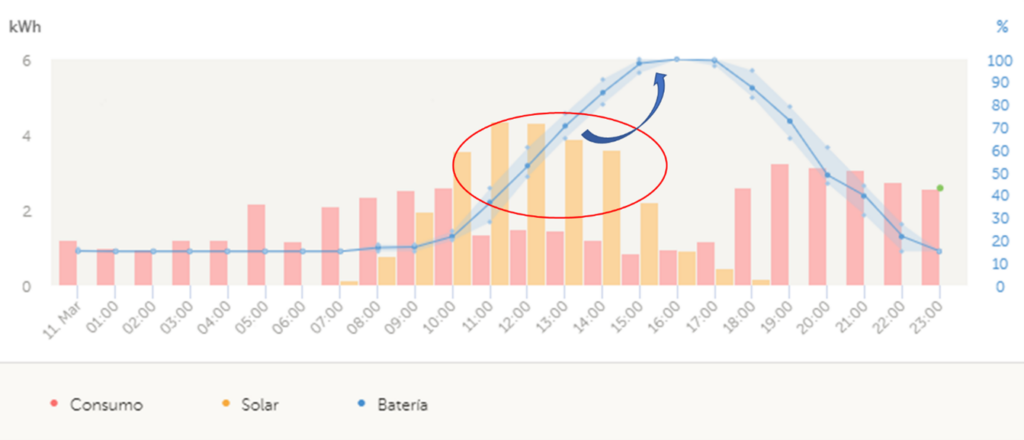REACT is a 4-year innovation project, funded by the Horizon 2020 program of the European Union.
Its objective is to achieve energy independence for the islands by combining renewable energy sources and their storage, with an active demand management platform, promoting the participation of users in a local energy community.
REACT develops a technical and commercial model that will demonstrate that these technologies can bring significant economic benefits, contribute to the decarbonisation of local energy systems, reduce greenhouse gas emissions and improve air quality, while generating significant savings. cheap to users.
RULES FOR USE OF THE FACILITIES
Self-consumption facilities work fully automatically. Once the start-up has been carried out, they do not need to be manipulated to start or stop them. If necessary, the intervention must be carried out by qualified personnel..
SAFETY INSTRUCTIONS
ELECTRICAL SHOCK HAZARD Installed equipment is used in conjunction with a permanent power source (battery). Even if the equipment is turned off, a dangerous electrical voltage may occur at the input and output terminals.
The equipment does not contain parts inside that can be manipulated by the user. Do not remove the front panel or the different devices of the installation. Maintenance operations must be carried out by qualified personnel.
WHAT IS SELF-CONSUMPTION?
Electricity self-consumption allows any person or company to produce and consume their own electricity by installing photovoltaic solar panels or other renewable generation systems in their home, premises or community of neighbors. In addition to promoting renewables, it represents savings in the electricity bill and less dependence on changes in the price of the electricity tariff, since part of the consumption is covered by the energy generated by the system. The new self-consumption regulations facilitate procedures, recognize the right to self-consume renewable electricity without tolls or charges, and allow these systems to be installed individually or shared, for example, in neighborhood communities.
The renewable energy generation system is connected to the electricity grid and to consumption at the border point (general framework for housing protection), thereby ensuring that:
- The consumer always receives energy from both generating sources (grid and photovoltaic), ensuring continuous supply to consumption.
- In the event of solar surplus, it is possible to pour the solar surplus into the electricity grid, obtaining compensation for it on the bill.
- In the event of a power outage, the system is capable of continuing to supply energy stored in the batteries.

ELEMENTS OF A PHOTOVOLTAIC SOLAR ENERGY INSTALLATION
1. PHOTOVOLTAIC CELLS (SOLAR PANELS)
Photovoltaic panels or modules (photovoltaic plates) —commonly called solar panels, or solar plates, although these denominations also cover other devices— are made up of a set of photovoltaic cells that produce electricity from the light that falls on them through the effect photoelectric.
Photovoltaic panels are normally installed on a structure designed in such a way that they have an optimal orientation for maximum use of solar energy.

2. SOLAR CHARGE REGULATOR
Charge regulators are one of the most important parts of the photovoltaic solar installation. The regulator is located between the panels and the batteries, and is in charge of controlling the voltage and intensity with which the latter are charged. It is a key piece, since it takes care of the battery and extends its useful life, protecting it against overloads or against very deep discharges. Thanks to the charge regulator, the state of charge of the battery is controlled at all times, and alarms can be generated if certain thresholds are reached.

3. INVERTER/CHARGER
The objective of the inverter in a photovoltaic installation is multiple: in addition to converting direct current electrical energy into alternating current energy, it has the capacity to improve the electricity that reaches the services, offering a safe and quality supply, to avoid thus the possible deterioration of the electrical equipment..
The inverter chargers also incorporate an internal charger capable of charging the battery using an external 230V power source, such as generator sets, the electrical network or gasoline engines.

4. BATTERIES OR ACCUMULATORS
The main mission of the battery within a photovoltaic solar system is to supply energy as it is demanded by the load, regardless of the electrical production of the panel at that precise moment.
The battery allows accumulating solar surpluses to self-consume them deferred (at sunset, for example), and to maximize the % of solar energy generated that is used without the need to feed it into the network.
In case of blackouts in the electrical network, a backup system can be available to feed consumption (critical consumers must be studied and a backup network must be generated in the home).
5. ELECTRIC METER
The bidirectional self-consumption electricity meter is a photovoltaic component that has the function of measuring the electrical energy that flows in a photovoltaic installation in two paths: from the network to the user (energy demanded) and from the user to the network (energy injected).
This device is essential in self-consumption facilities with surpluses covered by the simplified compensation mechanism. The approval of the current regulation of self-consumption, RD 244/2019, made it possible for users to receive a discount on the electricity bill for the energy poured into the network. This component is responsible for measuring the amount of excess energy that has been injected.
The energy that is finally transformed for consumption (alternating current) is passed through a meter to quantify the energy consumption of the installation.

6. MONITORING PANELS
The monitoring panel offers real-time information at a glance and allows you to control all connected products in the installation. This device is normally placed next to the inverters.
ENERGY MANAGEMENT PLATFORM AND APP
WHAT IS A PLATAFORM?
A Platform is a system that allows you to manage data and run applications or services centrally that provide added value to the Data.
An energy management platform is a system that:
- Manages energy data: electricity consumption in the home, photovoltaic production of renewable energy, energy storage
- Provides energy services that provide added value features for more efficient management of generated and stored energy, with the aim of maximizing the use of clean energy generated and reducing the end user’s electricity bill.

PLATAFORM OBJECTIVES
- Maximize the use of generated energy
- Efficiently manage stored energy
- Reduce the electricity bill of the end user
- Automate the operation of the equipment to align generation and consumption both at an individual and community level.
- Offer recommendations for decision-making in the flexibility of consumption
MANAGED DATA
The data managed by the platform is the data monitored by the photovoltaic installation.
WHAT DATA is managed?
- Energy consumption of the home / building / community
- Data from photovoltaic installations: power generation power, battery storage capacity…
- Thermal management elements, heat pumps, air conditioning systems (if they exist)…
ADDED VALUE FUNCTIONALITIES
- Weather forecasts
- Predictions of generation of photovoltaic energy production
- Predictions of energy consumption in the home / building
- Recommendations to optimize energy management both at individual and community level
- Flexible automation of facility management
MOBILE APP
The mobile application is the installation monitoring tool for the participant, the tool for sending recommendations, advice on energy management and consumption reduction or notifications for carrying out manual actions to more efficiently balance their consumption throughout the of the day
APP description
The APP home screen is divided into three sections and displays the following information:
- The energy saving in €/year, the reduction of Kg of CO2 emitted into the atmosphere and the equivalence in trees in relation to the reduction of CO2 since the start of operation of the installation
- Savings throughout the Island
- Information on the status of the installation: battery charge status, heat pump temperature (if any) and solar production power

The most relevant energy information can be viewed on the Energy screen of the APP:
- Power generation from the solar panels and the energy consumption of the building, being able to select a daily, weekly, monthly and annual period.
- Displays of some relevant data of the installation such as the energy meter and the energy consumption trend.

On the Equipment screen of the APP you can view information regarding the percentage of self-consumed energy, information on photovoltaic production, the state of charge of the battery and, if present, the state of the heat pump will also be displayed.

On the Prediction screen of the APP, the information of the information of what can be the production and the demand of the estimated daily energy of the installation is displayed. The weather forecast for the area is also available.

In the options menu we can access the information of the installation that shows the technical characteristics of the installation, the notifications received, sent by the REACT2020 platform of advice and recommendations to reduce energy consumption or to carry out some manual action to effectively balance energy produced, the settings menu for personalizing the APP, where you can choose a language, enable notifications, etc., the REACT2020 menu allows us to access the REACT2020 project website and finally access to the APP tutorial.

WEB MANAGER
There is the option of accessing the management platform through a web service with the same functions that we can find in the APP:
- Monitorización del estado de las instalaciones: producción de energía, consumo dMonitoring of the status of the facilities: energy production, energy consumption, storage status
- Visualization of the most relevant indicators of the facilities
- Monitoring of production and consumption forecasts for the current day
- Energy prices

RECOMMENDATIONS FOR THE MAXIMUM USE OF SOLAR PHOTOVOLTAIC ENERGY
To begin with, it is necessary to be aware that solar energy generation occurs during daylight hours, so it is important to try to self-consume all that energy as much as possible.
Plotting the production curves of a photovoltaic system and electricity consumption of a home on a graph, like the one in the figure, it can be seen that there is a profound decoupling between production and consumption.

We can see that as a standard, electricity consumption is irregular and has some peaks in the morning, at noon and at night, while solar production is regular and covers the central hours of the day. In this time slot, therefore, there will be a surplus that will be stored in the batteries to be used at times of low solar production and the rest will be fed into the network.
La optimizacion y el aprovecjhamiento de la energía consiste en tratar de desviar los consumos eléctricos a aquellas franjas horarias en las The optimization and use of energy consists of trying to divert electrical consumption to those time slots in which there is radiation (production). We can do this manually, that is, by starting up electrical consumption devices (washing machine, dryer, water heating, heat pump, etc.) when we see that we have surplus generation.

The battery allows accumulating solar surpluses to self-consume them deferred (at sunset) in this way it is possible to maximize the % of solar energy generated that is used without the need to pour it into the network. In case of blackouts in the electrical network, a backup system can be available to feed consumption.

